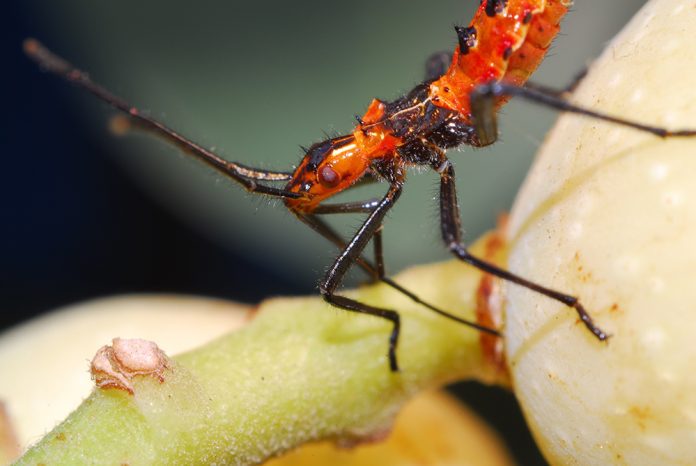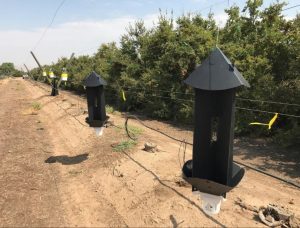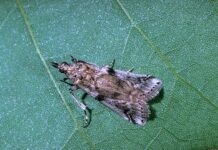
Monitoring for leaffooted bug (LFB) invasions in almond and pistachio orchards is presently mostly a visual effort. Scouting orchards for signs of this large hemipteran pest begins when warm weather draws overwintering adults into orchards to feed. The trouble is damage to the developing crop may have already occurred before LFB are found. Or growers spend money on insecticide spray applications that may not be warranted.
Significant progress toward an ‘early warning system’ has been made in recent years with identification and synthesis of an aggregation pheromone. This attractant and an effective trap may give almond and pistachio growers a better picture of the potential for crop damage and justification for an insecticide spray.
Adult leaffooted bugs are large, measuring 0.75 to 1 inch in length and have large, strong mouthparts. The three main species of LFB in California have similar brown coloring with a narrow white band across the back. Their hind legs have an expanded appearance that resembles a leaf. Presently, the most common LFB species found in tree nut orchards is Leptoglossus zonatus, which can be identified by the two yellow spots on the plate-like structure that covers all or part of the thorax. UC Riverside Entomologist Jocelyn Millar said 20 years ago the LFB species Leptoglossus clypealis appeared to be the most common species affecting California crops, but for reasons unknown, L. zonatus has now become dominant. L. clypealis does not have the yellow spots, but has a long, pointed feature on its head.
LFB overwinter as adults in protected areas, including under bark of eucalyptus, citrus or ornamental trees. They can also be found in crop debris. Beginning in March, the adults move to find food sources. Developing nuts become a food source as native vegetation dries down. Leaffooted bugs are strong fliers and can quickly invade an orchard seeking food. After mating, LFB lay eggs on leaves, twigs and nuts. Nymphs emerge and develop into adults in six to eight weeks, according to UC IPM guidelines. Adult LFB lay eggs over an extended period, resulting in all life stages being present by late June.
In almond orchards, LFB can cause significant damage when adults feed on young nuts before shell hardening. This can cause the embryo to wither and abort or may cause internal gumming. Nuts damaged by LFB feeding during or shortly after bloom will darken and drop. Nuts which are damaged when they are enlarging will have damaged tissue that turns brown and necrotic and develops a sunken appearance. After shell hardening in June, LFB feeding can damage kernels. Softer-shell varieties are more susceptible to LFB damage for longer periods during the growing season.
Crop Damage on the Rise
Mel Machado, grower relations with Blue Diamond, said more almond growers are becoming aware of the plant bugs in their orchards, including LFB. Damage from these large bugs has increased over the last several years. In almonds, the Price, Aldrich, Fritz and Sonora varieties are particularly susceptible to LFB feeding.
“I always tell growers to walk those varieties first,” Machado said.
Without a pheromone attractant and trap, growers and managers must spend time scouting orchards to determine if they have an LFB infestation. Machado said they need to look for sting wounds on the hulls, gumming and egg masses. Adults can be difficult to spot as they move quickly. An exception, Machado said, is when LFB are mating, the pair will not move.
There are no good insecticide materials that will kill the adults without creating other problems, Machado said.
Houston Wilson, UC Riverside entomologist, said pistachio nuts are vulnerable to LFB feeding in June. LFB often damage most of the nuts in a cluster. Feeding causes blackened or dropped nuts before shell hardening. After shell hardening, nuts do not drop from the rachis. External signs of feeding may only be a pinpoint on the hull. LFB can continue to feed long after shell hardening if they feed near the fruit peduncle, or the “stem” that connects the fruit to the rest of the cluster. The shell is weaker in that area and less able to protect the fruit; feeding attempts in other areas of the fruit during the late season are less likely to result in kernel damage. The second type of damage is kernel necrosis where the kernel develops a sunken or distorted area and may have an off flavor.
Pheromone Research
Millar said development of an attractant for LFB monitoring has been a long-term goal. With a proven attractant, he said growers can see when LFB are migrating into orchards and apply appropriate control measures. The research has been funded by the California Pistachio Research Board and Almond Board of California.
The multi-year pheromone work has included isolation, identification and synthesizing nine compounds from sexually mature male Leptoglossus zonatus, the dominant LFB species in California.

Millar reports the research efforts were primarily aimed at producing a pheromone lure that attracted both male and female LFB. A big hurdle in developing a practical lure will be producing the main compound of the lure or attractant in large enough quantities. Millar said it took two years to collect enough of the key active component from virgin males to purify into a few micrograms to identify the compound. In 2021, they confirmed that a compound that they have given the name leptotriene as the key component in the attractant. Their efforts are now concentrated on the minimum set of the other components which are necessary for an active lure, making it more manageable to produce.
Millar said that when the pheromone lure is available in commercial quantities and paired with an effective trap, this “early warning system could be a more efficient method of determining when LFB are invading an orchard. Along with an established economic threshold, growers then can make informed management decisions as to whether control measures are warranted.
The lure and trap combo for LFB is another part of the research. Wilson said lures were initially tested with sticky traps, but LFB, due to their size, are often able to pull themselves free. A better trap design, where LFB fly in, hit the hard surface of a vertical panel and drop into a container that is coated with a Teflon-like material to keep them from climbing out is being tested, Wilson said.
A successful lure and trap design, he said, will help with development of an economic threshold for LFB in almond and pistachio orchards. That will aid in management decisions and could result in fewer spray applications.
Risk assessment of known adjacent habitat for LFB is also part of an IPM strategy. The lure and trap can be used as a tool to monitor suspect sites and confirm population trends.











